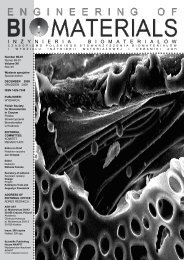69-72 - Polskie Stowarzyszenie BiomateriaÅów
69-72 - Polskie Stowarzyszenie BiomateriaÅów
69-72 - Polskie Stowarzyszenie BiomateriaÅów
Create successful ePaper yourself
Turn your PDF publications into a flip-book with our unique Google optimized e-Paper software.
40 Z drugiej strony, Charlesby [2] już prawie 50 lat temu<br />
stwierdził, że obecność czwartorzędowych atomów węgla<br />
w polimerze ułatwia pękanie łańcucha głównego. Dlatego<br />
w poliizobutylenie (PIB) łańcuch główny polimeru ulega<br />
łatwo zerwaniu podczas radiolizy. Utworzony w takim<br />
przypadku trzeciorzędowy rodnik charakteryzuje się dużą<br />
A copolymer constructed from two blocks – hard block<br />
(domains) of PS resistant to ionising radiation and soft<br />
sequences of radiation degradable PIB - served as an interesting<br />
object for studying these contradictory tendencies.<br />
For comparison, polystyrene-polybutadiene-polystyrene<br />
(PS-PB-PS) was also investigated.<br />
stabilnością, a po przegrupowaniu strukturalnym fragmentu<br />
makrocząsteczki pęknięcie ulega utrwaleniu.<br />
Interesującym materiałem dla badania tych obu przeciwstawnych<br />
tendencji jest kopolimer zbudowany z dwóch bloków<br />
– sztywnych domen polistyrenu odpornych radiacyjnie<br />
i giętkich sekwencji poliizobutylenu ulegającego degradacji.<br />
Przeprowadzono również badania porównawcze z wykorzystaniem<br />
kopolimeru polistyren-polibutadien-polistyren<br />
(PS-PB-PS).<br />
Materiały i metody<br />
Próbki kopolimerów przygotowane w formie pasków folii<br />
o szerokości 3mm został napromieniowane w akceleratorze<br />
Elektronika (strumień elektronów o energii 10MeV),<br />
a następnie umieszczone w kwarcowej rurce EPR. Pomiary<br />
metodą spektroskopii EPR wykonano przy użyciu spektrometru<br />
Bruker ESP 300 w paśmie X przy mocy mikrofalowej<br />
równej 1mW. Napromienienie w warunkach kriogenicznych<br />
przeprowadzono w źródle 60 Co o mocy dawki 1,2kGy/h.<br />
Wyniki i ich dyskusja<br />
Podczas ekspozycji na promieniowanie jonizujące<br />
poliizobutylen ulega degradacji [2]. Na podstawie badań<br />
przeprowadzonych metodą NMR Hill i in. stwierdzili, że<br />
dominującymi produktami trwałymi są P1 i P2 powstające<br />
wg poniższego mechanizmu [3]:<br />
SCHEMAT 1.<br />
SCHEME 1.<br />
Rodnikowe produkty przejściowe powstające wg Schematu<br />
1 są nietrwałe w temperaturze otoczenia, dlatego<br />
w warunkach w których prowadzono eksperymenty, ich widm<br />
EPR nie obserwowano. Zgodnie z przedstawionym mechanizmem<br />
pęknięciom łańcucha głównego nie towarzyszy<br />
uwolnienie atomów wodoru. Jednakże w makrocząsteczkach<br />
węglowodorów promieniowanie inicjuje równocześnie<br />
homogeniczną dysocjację wiązania C-H, w wyniku której<br />
odszczepiony atom wodoru tworzy produkt cząsteczkowy,<br />
np. H 2 , lub przyłącza się do podwójnych wiązań.<br />
W kopolimerze PS-PIB-PS powstający w ten sposób wodór<br />
może przyłączyć się do grupy fenylowej w pozycji orto lub<br />
para [4]. Dowód na przebieg takiej reakcji można znaleźć<br />
na Rys.1. Małej intensywności sygnał obserwowany bezpośrednio<br />
po napromieniowaniu po obu stronach dubletu<br />
należy prawdopodobnie do rodnika cykloheksadienylowego<br />
postulowanego przez Salih’a i in. [4].<br />
Dominujący w widmie eksperymentalnym dublet składa<br />
się z dwóch linii o rozszczepieniu nadsubtelnym 1,2mT.<br />
Aby zidentyfikować powyższy sygnał obecny w widmie PS-<br />
PIB-PS, uzyskane wyniki EPR porównano z absorpcją jaką<br />
wykazuje napromieniowany PS-PB-PS. W tym przypadku<br />
widmo rodnika składa się z kwartetu o rozszczepieniu<br />
zbliżonym do obserwowanego dla PS-PIB-PS, t.j. 1,2mT,<br />
Experimental<br />
Block copolymer samples were prepared in film form,<br />
subsequently were cut into 3mm wide slices, irradiated with<br />
an Elektronika accelerator (with 10MeV electron beam of<br />
energy) and inserted into quartz tubes. EPR measurements<br />
were performed on a Bruker X band ESP 300 spectrometer.<br />
Microwave power was set at 1mW. Irradiation under<br />
cryogenic conditions was carried out in a 60 Co source with<br />
a dose rate of 1.2kGy/h.<br />
Results and discussion<br />
Polyisobutylene undergoes degradation during exposure<br />
to high energy radiation [2]. On the basis of NMR<br />
experiments, Hill et al. suggested that P1 and P2 are the<br />
most abundant stable products forming via the following<br />
mechanism [3]:<br />
The intermediate radicals shown in scheme 1 are<br />
unstable at ambient temperature therefore their EPR<br />
spectra were not detected under the experimental conditions.<br />
According to this mechanism main chain scission<br />
does not lead to the production of hydrogen atoms.<br />
However, in hydrocarbon macromolecules irradiation<br />
induces homogeneous dissociation of C-H bonds and<br />
abstraction of hydrogen that subsequently can form<br />
either molecular products, e.g. H 2 , or attack unsaturated<br />
moieties. In PS-PIB-PS the released hydrogen atoms<br />
might be attached to the phenyl groups of the PS block at<br />
para or ortho positions [4]. An EPR evidence of such a process<br />
is demonstrated in Fig.1. The low intensity absorptions<br />
detected directly upon irradiation to the left and right of the<br />
dominant doublet might be attributed to cyclohexadienyltype<br />
radicals postulated earlier by Salih et al. [4].<br />
The dominant doublet is composed of two broad lines<br />
of hyperfine splitting near 1.2mT. In order to interpret the<br />
doublet observed in the PS-PIB-PS spectra, the signal was<br />
compared with the absorption of irradiated PS-PB-PS. In<br />
the latter case a quartet of the same hfs, i.e. 1.2mT, was<br />
recorded, as shown in Fig.2. At 77K unresolved signals<br />
of other radicals are revealed in the form of a wide singlet<br />
(see Fig.2D).<br />
The dominant spectra of both copolymers might be assigned<br />
to the same type of radicals as their shape does<br />
not change with the elapse of time and absorption dose.<br />
We suggest that in both copolymers, PS-PIB-PS and PS-<br />
PB-PS, the main radicals created by irradiation at ambient<br />
temperature have the same structure and are located in<br />
the PS domains. Our proposal is based on the following<br />
arguments: (i) radicals situated in PIB and PB are unstable<br />
at RT, (ii) the spectral range of the dominant signals in both<br />
cases remains comparable (although the lines detected













